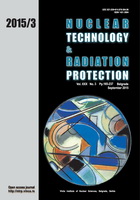
DEVELOPMENT AND DOSIMETRIC CHARACTERIZATION OF INDIGENOUS PADC FOR PERSONNEL NEUTRON DOSIMETRY

Vol.
XXX, No. 3, Pp. 165-237
September 2015
UDC 621.039+614.876:504.06
ISSN 1451-3994
Pages: 175-187
Authors: Rupali Pal, Vishnu S. Nadkarni, Diptesh Naik, Mudit Beck, Ashok Kumar Bakshi, Mohan Pundarinath Chougaonkar, Ghanshyam Chourasiya, Yelia Shankaranarayana Mayya, and Devu Appala Raju Babu
Abstract
CR-39 is a solid state nuclear track detector, chemically known as poly-allyl-diglycol-carbonate, widely used for personnel neutron monitoring because of its sensitivity to neutrons, excellent optical properties that facilitate the analysis and sufficiently long shelf life. Presently, this detector is imported and is being used for the personnel neutron monitoring programme in India. Hence, an effort was made towards the indigenous development of these detectors. Different chemical processes for the indigenous development of the poly-allyl-diglycol-carbonate detector, such as the synthesis of allyl-diglycol-carbonate monomer and isopropyl- peroxydicarbonate as initiators for the polymerization process, were carried out and are reported in this paper. A method for casting unbroken poly-allyl-diglycol-carbonate sheets sized 25 cm x 15 cm and of a thickness between 500 µm and 800 µm was developed. A longer polymerization process also helps to increase neutron sensitivity, reduce the minimum detection limit and increase the signal-to-noise ratio of the detector. The study suggests that it is possible to develop indigenous poly-allyl-diglycol-carbonate detectors with a minimum detection limit of 0.1 mSv and signal-to-noise ratio of 8.0.
Key words: poly-allyl-diglycol-carbonate, electrochemical etching, neutron dosimetry
FULL PAPER IN PDF FORMAT (4.37 MB)